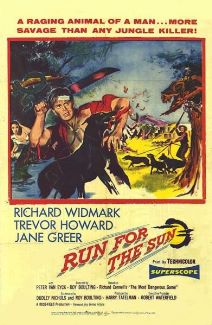1956: Run For The Sun
Run For The Sun (Roy Boulting, 1956) 5/10
 Anthologized in 1924, Richard Connell's short story The Most Dangerous Game has been the source material for countless films. Elements of Connell's work can be found in such diverse material as Cornell Wilde's The Naked Prey (1966) to 1977's Bond film Octopussy. Its premise is simple: man, the hunter, also becomes the hunted.
Anthologized in 1924, Richard Connell's short story The Most Dangerous Game has been the source material for countless films. Elements of Connell's work can be found in such diverse material as Cornell Wilde's The Naked Prey (1966) to 1977's Bond film Octopussy. Its premise is simple: man, the hunter, also becomes the hunted. Inspired by the big-game hunting safaris enjoyed by affluent European and American travellers in the late 19th century, Connell inverted the scenario by twisting the rules of the game. Rather than having man hunting wild beasts in exotic locales, Connell wrapped his original story around the plight of a shipwrecked man, who becomes hunted by a savage and sinister Cossack.
In doing so, Connell created a work that twisted the colonial paradigm of the era, infusing it with the unfettered savagery and bleak humanity, Connell and his peers witnessed during the First World War. Hollywood first picked up on Connell's story in 1932 with its first official adaptation by Irving Pichel and Ernest Schoedsack for RKO. Thirteen years later at the end of the Second World War, RKO released a remake helmed by Robert Wise at RKO entitled Game of Death. Poorly received, Wise's work altered the hunter's background from a Cossack to a exiled Nazi. It is this strand that the second official remake of the story, 1956's Run For The Sun, undertakes as its focal point.
Released in 1956 by MGM, Run For The Sun was the lone American film made by British director Roy Boulting. Set in Mexico, the film centers on Mike Latimer (Richard Widmark), a reclusive Hemingway-esque writer living an anonymous existence in the fishing village of San Marcos. His short-lived exile is soon interrupted by tabloid journalist Katy (Jane Greer). Claiming to be a tourist stranded in the village waiting for friends, Katy strikes up a relationship with Mike, who is oblivious to both her profession and purpose. After prodding and probing him for answers about his failed relationships and inconsistent output, she takes his offer of a flight in his private plane back to Mexico City.
Swerving off-course, the plane crashes into the dense Mexican jungle. Far from civilization, the pair are relieved to find a group of European settlers, Browne a British plantation owner (Trevor Howard) and van Anders a Dutch archeologist (Peter van Eyck), operating a small farm in the thick forested region. Despite the gracious hospitality afforded to them, the pair are soon perturbed by the antics of their hosts. Rifts emerge due to the web of clandestine pasts and concealed identities in the tropical heat. Mike, in particular, begins to suspect the origins and war-time practices of the plantation proprietors; conversely Katy's less nefarious designs also come to the forefront. Fearing for their safety, the couple quickly mend their differences, as they head east toward the beach: racing for the sun in the name of survival.
Heavy on action, Run For The Sun is a brisk B picture on an A-budget. Obstinately a film about closeted personal histories, Run For The Sun is a visually flavourful romp; a Saturday matinee classic that probably would have easily entertained many a twelve year old boy in 1956. Secretive pasts swirl at the forefront of the film's exotic settings. The revelation of the characters respective backgrounds throughout the film, brings a sense of uneasiness to each individual. This restlessness emerges because has much to lose in the process of disclosure.
The unearthing of Mike's reclusive home disrupts the alcoholic, self-pity he has drowned in, since the failures of his last book and his last relationship. In leaving its destructive, but comfortable climes, Mike puts himself in a position to be emotionally hurt once again. By having her professional credentials revealed to the intensely private Mike, Katy knows she will likely lose not only Mike's trust, but also their blossoming relationship. Certainly the pair of Browne and van Anders have the most to lose in this ordeal. By having their treacherous Nazi origins unmasked, the duo open themselves up to lose everything: their money, their obscurity and possibly their lives.
In response to this threat, Browne and van Anders engage in hunting the American couple for sport: an act that typifies the physical and psychological cruelty Browne and van Anders represent and regularly enact on the local indigenous tribes. Yet, the manner through which director Roy Boulting explores their dilemma is primarily muted. For much of its ninety-nine minute running-time, Run For The Sun feels shorn of character development and insight.
At the expense of narrative, action is placed at a premium: yielding a nimble production that darts along, but fails to maximize its own potential. As a result, much of the film's suspense is blunted, as speed takes preference. Characters suss out each other's intentions far too easily. For example, the manner through which Boulting and screenwriter Dudley Nichols explore the wartime relationship between Widmark's Mike and Trevor Howard's Browne is particularly underwhelming. Greer's descent from independent career woman to middling damsel in distress is also astonishingly poor in lieu of the materials' potential.
Nevertheless in spite of its flaws, Run For The Sun is an entertaining, if not particularly memorable film. While Widmark plays his role by the numbers, Trevor Howard delivers a scintillatingly sinister effort as the Nietzsche espousing "hunter" Browne. Yet, perhaps the film's greatest star is cinematographer Joseph LaShelle, whose cinematography is the film's greatest reward, adding a humid frenzy to the classy MGM production values.
* Run For The Sun is available on R2 DVD through Optimum Home Video
Copyright 2008 8½ Cinematheque

<< Home